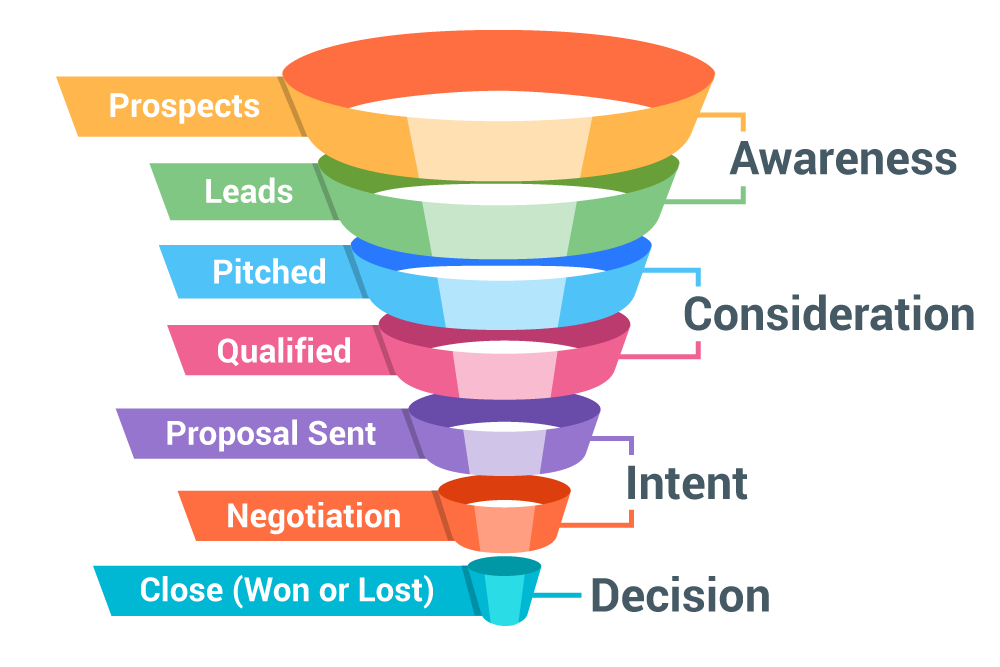Want to build a growth-focused business? You must constantly win over new customers. While it's a common occurrence for corporations, frequently closing repeated deals is grueling for a start-up.
To do so, you need a reliable, repeatable sales process proven to work. This will help your sales team avoid long sales cycles and quickly interest your prospects in your product.
With a repeatable sales process, a business can:
- Maintain consistency and efficiency in sales
- Empower the sales team to deliver tangible results
- Define the ideal customer and target high-value prospects
- Make conversion more streamlined, improving customer satisfaction
But for a bootstrapped business with small teams, taking such a structured approach to sales can be quite challenging.
So, here is a 9-step guide to building a repeatable B2B sales process that will boost your revenue in no time.
Here’s what you need to do to get started.
1. Define your sales objectives
The first thing every sales strategy needs is a clear vision of the aspired outcome. So, before you create a repeatable sales process, figure out your sales goals and objectives. This will determine a specific way for your sales rep to follow and simplify delivering results.
This can vary depending on what stage your business is at, the size of your workforce, and your revenue targets. For example, a new business looking to build a robust customer base will have a different approach than an established company with a loyal following.
Identify the key metrics so that you can monitor the success of your process as soon as you apply it. Remember to audit your budget to ensure a cost-effective strategy.
Finally, examine your current sales process to find loopholes. This way, you can determine your objectives more accurately. Businesses can analyze competitors’ sales processes and outcomes to understand their position in the market. With precise benchmarking, you can also align your goals with your company’s vision and mission.
2. Understand your target audience
The primary aim behind building a repeatable sales process is winning over new customers effortlessly. For that, start viewing the sales process from the customer’s perspective.
This demands a thorough understanding of your target market. Collect customer data and analyze it to build ideal customer profiles.
Here are some simple questions you need to ask yourself:
- What problems are you solving?
- Who desires these solutions?
- Why will your target audience choose you over competitors?
- How can you deliver a better service than other brands?
The answers will help identify your audience’s pain points and desires. You will categorize customers accurately for better personalization. This way, you can create an adaptable process suitable for accommodating different customer segments. A clear and segmented ICP lets you provide the sales team with everything they need to build strong connections with prospects.
While knowing what a client wants is vital, you must also understand why a prospect isn’t a good fit for your services. This lets you maintain consistent branding and build a happy customer base.
3. Develop a sales framework
Once you have clear objectives and accurate ICPs, it’s time to map out the stages of the process. Examine your current and previous sales cycles to determine the required steps.
Here are some general steps of a sales process:
- Marketing qualified lead
- Brand awareness
- Engagement
- Sales interaction
- Prospecting
- Negotiation
- Needs analysis
- Demonstration
- Verbal agreement
- Contract signing

To ensure accuracy at each stage, define specific actions and milestones for each. This will empower your team to stay focused and navigate the pipeline better. Create a comprehensive visual mapping of each stage and its flow to maintain consistency across the process.
Sales require teamwork. As your sales reps repeatedly deal with the customers directly, they can provide valuable input to fine-tune the process. So, ensure you involve every stakeholder while mapping the framework.
Businesses should also have feedback loops and checkpoints at every stage to monitor efficacy. Regular tracking lets you detect issues early on and improve them to make the sales process repeatable.
4. Establish sales tools and technologies
A repeatable sales process streamlines customer acquisition by providing clear guidance to the sales team. But strategic steps won’t be enough to deal with increased leads as your company grows.
Companies are relying on technology to make the process more efficient. 77% of sales professionals state their organizations plan to invest more in sales intelligence tools.
To make the process effortless, here are the AI sales tools you need:
- CRM
- Sales intelligence and prospecting tools
- Sales analytics
- Communication and collaboration tools
A scalable CRM acts as a multi-tiered support system for your sales team. It will facilitate seamless customer interactions, keep track of existing customers, and score leads. Its AI-powered automation eliminates repetitive steps, allowing your sales executives to focus on customer needs.
With sales intelligence tools, companies can gain high-quality leads and inspect them better with the right data. Analytics features empower your team with accurate insights into the process’s success. With real-time reports, you can detect issues with the process and resolve them better.
5. Train and empower your sales team
Initiating a repeatable sales process entails structural changes, which will be new for your sales team. To help them acclimatize, thorough training is an absolute must.
Once you have a graphic representation of the sales process, ensure your team understands the ins and outs of it. Gamification is an effective way to help them comprehend concepts easily.
Train them on current sales methodologies on personalizing communication with each segment.
Assess each sales rep's strengths and weaknesses to decipher which categories suit them. Ensure your training module is adaptable to suit each employee’s learning style.
Arrange seminars and workshops to give them hands-on experience. Prepare resources around repeatable sales processes and make those accessible around the clock. You can set up a Trello board or use a Notion template to ease them into the process. Create modules with FAQs to make learning easy.
Your sellers will also heavily rely on your CRM to manage deals and customer relationships and ultimately meet their sales goals and targets. That means CRM adoption is critical to your sales training and enablement strategy. Empower your sales team with contextual in-app guidance, task walkthroughs, tooltip reminders, progress change alerts, and self-help support within your CRM with a digital adoption platform.

6. Create sales playbooks
A sales playbook guides sales teams that share proven sales tactics, strategies, and best practices. It lays down the guidelines of the sales process, effective negotiation tactics, etc.
Here are some usual chapters every sales playbook should have:
- Sales outreach
- Case studies
- Checklist to qualify leads
- Demonstration
- Follow up
- Negotiation
- Conversion
While creating a sales playbook, include infographics to make it more comprehensive. Understand what your reps are struggling with the most and prioritize them in the playbook. Audit your existing sales collateral to see what topics you need to include.
Determine collaborators like sales VPs, managers, and team leaders and ask for their suggestions. Add scripts, objection-handling strategies, and value propositions so your team can handle any situation. Include plenty of real-life examples to show how a repeatable process works. Keep the literature simple and highlight the topics with visual designs.
Besides equipment, resources, and training, foster a culture of continuous development and learning in your organization. Reward the team's improvements and encourage synergy across departments.
Lastly, be goal oriented. Neal Taparia, founder Play-Minesweeper, explains, “Makes sales simple and sets goals they need to reach every funnel stage. We sell some custom games, and the rest falls into place if our team hits their number of outbound calls.”
7. Implement clear communication channels
Aligning your sales and marketing department at every stage is necessary to create a successful, repeatable sales process. For that, you need seamless communication and collaboration between the teams.
Create a culture of open communication in the workplace. Establish regular sales meetings to discuss current hurdles. Make collaboration a priority in both departments.
Incorporate a scalable communication tool in your internal system for real-time updates and feedback. This simplifies collaboration by keeping every involved professional on the same page. The process becomes seamless, driving better results.
8. Measure and analyze sales performance
The focus shouldn’t be just numbers. But monitoring progress will keep on top of the process and detect issues early on. Identify relevant KPIs to track and measure sales performance.
Here are some key metrics you should monitor:
- Conversion rate
- Customer acquisition cost
- New leads in the pipeline
- Customer lifetime value
- Churn rate
- Retention rate
- Average revenue per customer
- Monthly recurring revenue
- Existing customer engagement
After implementing your repeatable sales process, make it a routine to track progress and pipeline health closely. Use AI-powered tools to ensure accuracy. Analyze the data to identify bottlenecks and areas of improvement.
9. Iterate and refine your sales process
Design your ideal repeatable sales process around long-term goals. Regular updates in the process are necessary to ensure a constant flow of new customers.
Once you implement a sales process, collect feedback from your team and prospects to measure its efficacy. Examine the generated reports to see what’s working and what’s not and proactively eliminate the detected issues.
Reaching the perfect, repeatable sales process takes time. Don’t be afraid to experiment with new strategies now and then to find the right approach for your business.
Conclusion
The point of a repeatable sales process is to bring structure into sales and bring in new customers consistently. You can do several things to create and refine a repeatable sales process. However, your actions should always be customer-centric and data-driven.
Collect accurate data and analyze them in real-time to never miss a sales opportunity. Ensure your efforts are not random and seamlessly fit your ultimate business goals. Choose tools that offer wide-ranging CRM integrations and can accommodate a growing sales team and customer base.
Finally, be open to new ideas to keep the process fresh. Remember, perfecting a repeatable sales process is not a one-day task. It takes time, discipline, and several trials and errors.
So be patient, measure progress, and trust your team’s capabilities.




